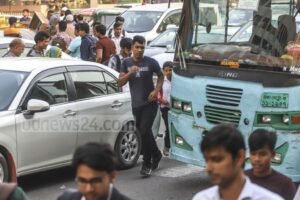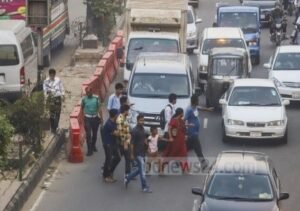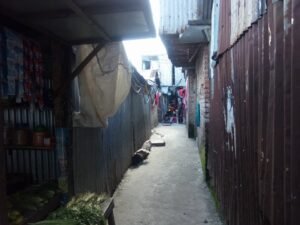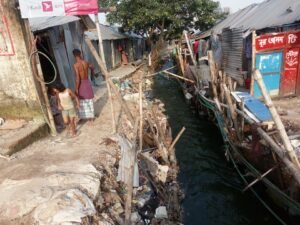This blog tells the unheard stories of part of urban population who are very important for our economy but often neglected. In Dhaka, people who reside in slums, mostly migrated from rural areas to get better employment opportunities. Yes, this blog is about their everyday transport mobility stories. Have you ever thought how these people meet their transport demand? Even though walking is sustainable transport choice. But walking is mostly neglected in Dhaka. Unfortunately, limited affordability of low-income people give them no choice but to walk long hours on severely bad roads without any walking facilities. This situation make low-income people more vulnerable compared to other who have more affordability.
According to the Bus Rapid Transit (BRT) Walkability Strategy report, about 19% of commuters use walking, with most of those earning less than 12,500 BDT (around $150), which brings into light the socioeconomic disparities in mobility. Nevertheless, the modal share for walking has significantly decreased by 40% between 1994 and 2010, showing a departure from this important mode of transportation. This blog tries to examine the vulnerabilities of low-income urban pedestrians in context of an urban slum, named Korail in Dhaka, highlighting the challenges they face in terms of obstacles and opportunities for sustainable mobility strategies. To examine this critical issue focus group discussions were held with Korail residents on July 2022.
Overall walking situation in Dhaka is reflected in these photos:



Understanding life in Korail Slum-Challenge and Resilience:
Colorfully vibrant, amidst all the noise and mess, the metropolis that Dhaka City is comes along with Korail Slum-reminding one of Dhaka’s inequality. The Korail slum lies just beside Dhaka’s richest zones, Mohakhali, Gulshan, and Banani. According to Brac’s (2014) report, Korail measures approximately 100 acres, with a recorded population of over 54,000 inhabitants. It seems due to being partially surrounded by water and geographically somewhat an island that Korail evidences disconnections between surrounding Banani and Gulshan , but concurrently speaks about resilience within its populace.
A Community Below the Poverty Line
Most people in Korail live below the poverty line on the minimum wages of domestic workers, garment factories, and informal sector jobs. Besides the hard struggles in life, one may observe a very close bond between the community members with each other, which remains key in overcoming everyday struggles. Still, poor infrastructure compounds many of these problems-especially issues of mobility and personal safety.
Infrastructure and Walkability: A Complex Dynamic
Recent initiatives by organizations such as BRAC and UNDP have made the roads inside the slum paved, increasing walkability for its residents. Many people cannot afford anything but walking as a major form of transportation. Be that as it may, there is tremendous vulnerability for mobility due to water-logging during monsoon times and general lack of public safety measures that strike at the livelihood of these residents, especially women and children.
Age and Demographics: A Young, Vulnerable Population
More of the Korail population falls within the 25 to 49 age brackets, which would presumably contribute to the local economy but is equally vulnerable to job insecurity and miserable living standards. Most of these people migrated from rural areas for better opportunities in the capital. However, the absence of upward mobility options has kept the poverty cycle impinging in every aspect on the way of life. Not only in Korail, this situation is evident in all low-income settlement in Dhaka and other cities in Bangladesh.
Inclusive City Planning: A Dire Need
Korail Slum epitomizes the dire need for inclusive city planning. These issues, pertaining to inadequate infrastructure, safety concerns, and lack of access to major services, require so much in the way of cooperation at the level of governmental agencies, NGOs, and the community itself. More investment in infrastructure, cheaper transportation, and employments may upgrade the livelihood of the residents in Korail and contribute toward overall urban development in Dhaka.
The Korail Slum epitomizes more than a community at the margin, representing resilience and a wake-up call for cities to think of ways that leave no one behind. We will understand its particular challenges and foster inclusive solutions so that a future is built wherein every citizen will get an opportunity to thrive in urban areas.
Theme Identifications from Focus Group Discussions
The focus group discussions involved three key demographic groups: male and female workers, elderly individuals, and children.
Group 1 highlighted the experiences of male and female workers , aged 16 to 40 years. The participant in this group commute averaging 30 to 40 minutes. Their income ranges between 4,000 and 5,000 BDT, with potential increases to 10,000 BDT with experience.
Group 2 focused on elderly individuals, both male and female, aged 50 years and above. Most of them have been living in the community for over 25 years and depend on their children or spouses for support, with some earning income as room owners. Their mobility is generally limited to the slum area.
Group 3 explored the challenges faced by children, aged 15 to 18 years, who travel up to 6 kilometers to reach their educational institutions, often on their own, while some attend schools within the slum.
These discussions revealed distinct transportation and mobility barriers for each group, emphasizing the need for tailored solutions to improve their accessibility, safety, and quality of life.
Insights identified from focus group discussions are discussed here:
Theme 1: Am I Getting My Rights?
The discussions in the focus groups showed high levels of concern about whether residents feel their rights are being met, especially in the areas of mobility and infrastructure. In the rainy season, for example, children are often unable to attend school due to impassable roads, illustrating how poor infrastructure can be an important obstacle to education. Shopkeepers occupying road space further limits mobility and creates unsafe conditions for pedestrians. Others are even afraid of being replaced; the narrower roads, they seemed to say, were protection from the attention of rich classes that would take over the space on their homes. The construction of paved roads by NGOs relieved many, but many remarked that these improvements still are nowhere near the standards enjoyed by affluent areas like Gulshan and Banani close by. These responses underline the urgent need for equitable infrastructure development fitted to the needs of low-income communities.
Theme 2: Is Traveling Comfortable?
The focus group discussions showed how each day is a struggle in the travel comfort of their living. Most participants needed to get up early and be ready for whatever uncertainties of the day might cause inconveniences, from bad weather to the possibilities of blocked roads. Traveling in muddy waters from the wet season infects their legs and feet, which always seems to make the commute more miserable. Long walks on uneven and poorly maintained roads leave the people tired, especially in night. The residents, reflecting on the better past days, said the already operational boat service was reasonably utilized for affordable traveling of students until its abolition by the concerned departments. One respondent stated:
“When there was boat I could travel very easily. I could cross the lake with 2 BDT. For student this travel was free! Even who did not have money could travel free. Now I don’t have this facility as boat service is stopped by the authority.”
A few parents who spared no effort to win amenities for their children toiled and purchased bicycles in addition to saving money. These experiences point out the dire need for better infrastructure and accessible transport options to improve comfort in mobility for the community.
Theme 3: Am I Safe When I Travel?
Safety concerns remain a significant issue for Korail residents, particularly when traveling outside the slum. While many feel safe within the boundaries of Korail due to community initiatives such as night security guards, the situation changes near the access roads leading to areas like Banani. These areas are prone to theft, snatching, and burglary, leading garment workers and others returning at night to travel in groups for safety. However, safety within the slum is not universal—female teenagers report feeling unsafe due to frequent instances of eve-teasing. These insights emphasize the need for enhanced security measures both within and outside the community to ensure safe travel for all residents. There were several fire incidents happened in Korail. There is no access to fire fighting vehicle into the middle part of the locality, where most people live and houses are located very densely. Fire fighters are very reluctant as well. On of the respondent stated:
“Because most of the time they (firefighters) come 2/3 hours after fire started. So I don’t feel safe. I feel, I may die at any time.”
Another participant stated:
“When there was boat service, after fire started, people could easily escape even with their stuffs. Now they we have that facility. We cannot escape very easily.”
Theme 4: Am I an Inclusive Traveler?
Feelings of exclusion amongst the residents about issues of mobility and accessibility have been reflected in the discussions of focus groups. A number of participants reported that they are not part of the larger transport system, either due to poor walking facilities or inability to afford public transport. The improper infrastructure puts them across small paths between congested houses, which again makes them feel segregated. There was a deep sense of neglect, with feelings from some residents that they are a burden to society. These responses strengthen the call for urgent transport policies and infrastructure that factor in the needs of disadvantaged communities.
Theme 5: My Day at Dawn
Among others, the wear and tear that daily life brings transcend with residents in Korail having to wake up so well before dawn. Prolonged walking in the ill-maintained roads of Korail also render them tired prior to actually commencing work, much less other job-related activities. For others, an almost hour-long trudge back home is supplemented in their exhaustion of the entire day with house chores to undertake. This relentless circle of exhaustion is also adversely affecting relationships with family and friends since so many can’t spare enough time, citing reasons for tiredness. Stronger infrastructure or transport would also reduce much physical hardship, hence improving living standards more satisfactorily.
Theme 6: Am I Free?
The dwellers of Korail felt that they were caged and restricted in daily life. Young females and teenagers complained of continuous harassment and eve-teasing both within and outside the slum, which restricts them from even walking or traveling freely. Apart from offering mobility, the available boat services earlier provided a source of income for some of its residents, and that facility is now withdrawn. So, they feel powerless with the discontinuation of such service and economically constrained too. The female teenagers were also sharing how they can’t even cycle within the slum. These insights underpin how safe, accessible, and inclusive mobility options are about regaining a sense of freedom and mastery over one’s life.
Photos inside Korail slum:


Conclusion:
In many of the developing countries, such as Bangladesh, the problems faced by marginalized urban communities reflect the deep-seated inequalities within infrastructure, access, and safety. This is reflected in the larger systemic issues that have emerged from discussions on mobility issues faced by slum residents in Korail. Crumbling road conditions, few transportation options, and associated high safety risks cause extensive hardship for working women, the elderly, and children in their daily travel. These challenges not only impede their efficiency but also bring to light the rampant social and economic inequalities that exist.
These vulnerabilities point to a more comprehensive, interrelated crisis that calls for immediate intervention. Only by addressing these issues would it be possible to provide inclusive urban planning, equal infrastructure development, and affordable transportation for all sections of society. Without targeted initiatives, the most marginalized might be further excluded from reaping the benefits of development in cities like Dhaka.
The resilience of communities like Korail is a clear testimony to their determination in overcoming such adversities; however, it also strongly points to the dire need for sustainable and humane solutions. Investments in infrastructure and mobility systems that bridge these gaps should be the priorities of governments and stakeholders so that urban growth is beneficial for all, not just a privileged few.
Written By: Sharmin Nasrin, PhD




Leave A Comment